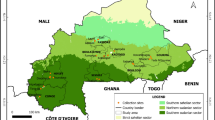Summary
Patterns of morphological diversity were examined in relation to geographical origins of 157 accessions of wild Lupinus angustifolius from the Aegean region using multivariate techniques. Genetic diversity was extremely large for most morphological traits, with significant variation detected among localities in Greece and within and between collection sites for some traits. Canonical variates and correlation analysis showed that early flowering, tall and large-seeded accessions were associated with warm winters and drier climates in southern Greece. Thirteen groups of accessions were identified by hierarchical cluster analysis of 19 morphological traits, accounting for 81 % of genotype and 41 % of genotype x trait sums of squares. The distinguishing features of these groups were clarified by principal coordinates analysis. Two groups, with very desirable agronomic characteristics, originated from the Dhodhekanisos Islands (Kos, Leros, Patmos) in the south-eastern Aegean: these had rapid and tall growth, prolific podding on the main stem, pods high off the ground, many upper lateral branches, large leaves, pods and seeds, and high seed yield. Accessions from the Kikladhes Islands of the central Aegean were extremely variable and those from Naxos Island were represented in 9 of the 13 groups. Accessions from northern Greece grouped together as later flowering, shorter, and smaller-seeded types, but some accessions from the southern Greek Islands were grouped with the northern mainland types. This study identified regions in Greece, such as the south-eastern islands, where further collection may be warranted for traits of obvious agronomic value for domesticated L. angustifolius. Extreme morphological variability occurs within and between collection sites, and between localities in Greece.
Similar content being viewed by others
References
Beuselinck, P. R. & J. J. Steiner, 1992. A proposed framework for identifying, quantifying and utilizing plant germplasm resources. Field Crops Res. 29: 261–272.
Bisby, F. A., 1970. The evaluation and selection of characters in angiosperm taxonomy: an example from Crotalaria. New Phytol. 69: 1149–1160.
Broich, S. L. & R. G. Palmer, 1980. A cluster analysis of wild and domesticated soybean phenotypes. Euphytica 29: 23–32.
Clements, J. C. & W. A. Cowling, 1990a. Summary of wild and semi-domesticated lupin accessions introduced to Australia from 1974 to 1989. Australian Plant Introduction Review 21(2): 1–14.
Clements, J. C. & W. A. Cowling, 1990b. The Australian Lupin Collection. Passport data for wild and semi-domesticated accessions introduced to Australia to 1990. Western Australian Department of Agriculture Research Report l/90.
Clements, J. C. & W. A. Cowling, 1991. 1991 Catalogue of the Australian Lupin Collection. Including field evaluation data for wild, semi-domesticated and fully domesticated accessions. Western Australian Department of Agriculture Research Report 3/91.
Cowling, W. A., 1986. Collection of Lupinus in Greece. FAO/IBPGR Plant Genetic Resources Newsletter 65: 20–22.
Cowling, W. A. & J. C. Clements, 1993. Association between collection site soil pH and chlorosis in Lupinus angustifolius induced by a fine-textured, alkaline soil. Aust. J. Agric. Res. 44: 1821–1836.
Downes, R. W. & J. S. Gladstones, 1984. Physiology of growth and seed production in Lupinus angustifolius L. III. Effects of defoliation and lateral branch excision on dry matter and seed production at different growth temperatures. Aust. J. Agric. Res. 35: 511–20.
Erskine, W., Y. Adham & L. Holly, 1989. Geographic distribution of variation in quantitative traits in a world lentil collection. Euphytica 43: 97–103.
Frankel, O. H., 1984. Genetic perspectives of germplasm conservation. In: W. Arber, K. Llimensee, W. J. Peacock & P. Starlinger (Eds), Genetic Manipulation: Impact on Man and Society. Cambridge University Press, Cambridge, pp. 161–170.
Gladstones, J. S., 1974. Lupins of the Mediterranean region and Africa. Western Australian Department of Agriculture Technical Bulletin No. 26.
Gladstones, J. S., 1989. Breeding Phomopsis-resistant lupins. Journal of Agriculture-Western Australia (4th Series) 30: 3–7.
Gladstones, J. S. & G. B. Crosbie, 1979. Lupin wild types introduced into Western Australia to 1973. Western Australian Department on Agriculture Technical Bulletin No. 43.
Greenwood, E. A. N., P. Farrington & J. D. Beresford, 1975. Characteristics of the canopy, root system and grain yield of a crop of Lupinus angustifolius cv. Unicrop. Aust. J. Agric. Res. 26: 497–510.
IBPGR 1991. Directory of Crop Germplasm Collections. 1. I. Food legumes. Arachis, Cajanus, Cicer, Lens, Lupinus, Phaseolus, Pisum Psophocarpus, Vicia and Vigna. E. Bennen-court, J. Konopka & A. B. Damania, International Board for Plant Genetic Resources, Rome.
Peeters, J. P. & J. A. Martinelli, 1989. Hierarchical cluster analysis as a tool to manage variation in germplasm collections. Theor. Appl. Genet. 78: 42–48.
Porter, N. G., 1982. Interaction between lateral branch growth and pod set in primary inflorescences of lupin. Aust. J. Agric. Res. 33: 957–965.
Seal, H. L., 1964. Multivariate statistical analysis for biologists. Methuen, London, UK.
Simpson, M. J. S., 1986a. Geographical variation in Lupinus albus L. I. Iberia. Plant Breeding 96: 232–240.
Simpson, M. J. S., 1986b. Geographical variation in Lupinus albus L. II. Northwest Spain, the Nile Valley, the Balkans and Turkey. Plant Breeding 96: 232–240.
Simpson, M. J. S. & R. McGibbon, 1982. Lupinus collection in Greece and Yugoslavia. IBPGR/PGRN 52: 28–30.
Sweetingham, M. W., 1986. Research into lupin root diseases. Journal of Agriculture-Western Australia 27: 49–52.
Author information
Authors and Affiliations
Rights and permissions
About this article
Cite this article
Clements, J.C., Cowling, W.A. Patterns of morphological diversity in relation to geographical origins of wild Lupinus angustifolius from the Aegean region. Genet Resour Crop Evol 41, 109–122 (1994). https://doi.org/10.1007/BF00053055
Received:
Accepted:
Issue Date:
DOI: https://doi.org/10.1007/BF00053055




